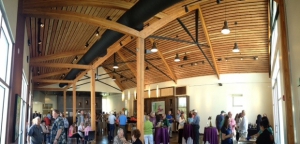Washington’s viticulture and enology research program is industry driven and supported.
Input from a widely distributed industry survey helps to develop research program priorities, keeping research relevant to industry needs.
Through grower and winery assessments collected by the statewide Wine Commission, the industry directly supports research and makes funding decisions.
But there’s room for more grower and winery involvement so that all understand its role and value and how to apply research outcomes.

The main hall in the Walter Clore Wine and Culinary Center in Prosser, Washington, on the first day of operation on May 30, 2014. (TJ Mullinax/Good Fruit Grower)
That’s why, for the first time, Washington wine grape growers and wineries attending the annual Research Review, scheduled for Jan. 18-19 at the Clore Center in Prosser, Washington, will be asked to provide input and rank presented projects.
These rankings will become part of the Wine Research Advisory Committee’s research-funding considerations.
As part of our emphasis on viticulture research at the Washington State Wine Commission, we also look for ways to elevate industry awareness of the importance of research.
The Research Review invites researchers to present progress or final reports of their work and pitch new proposals to the Wine Research Advisory Committee, a subcommittee of the Wine Commission.
It is a competitive process because all projects, even those ongoing, must seek grant funding. As the industry’s scientific review arm, the advisory committee makes research grant funding recommendations to the Wine Commission board.
The last two annual research reviews were opened to Washington grape growers and wineries. Small gains in attendance were made, but not nearly enough considering the importance of this annual event.
The Research Review provides insight into the Washington State Grape and Wine Research Program and is an opportunity to hear firsthand the progress being made to solve issues and improve wine quality.
It is here that innovative ideas and concepts are unveiled. More details about the Research Review will follow, but this is one winter meeting where you can provide input for the direction of the research program.
‘Aha’ research moment
Reading a technical research report is a sure cure for insomnia. But hearing and seeing that same information, summarized and presented by the researcher himself/herself, the message takes on new meaning and relevancy.
One goal of the Washington State Wine research program is to make Washington viticulture and enology research accessible to every grape grower and winery in the state.
Easily accessed industry-supported research connects the growers and wineries with the industry’s research partner, Washington State University, to create that “aha” research moment when the accessed information has direct application to your operation.
In 2016, Washington State Wine and WSU launched WAVE (Washington Advancements in Viticulture and Enology), a research seminar with the goal of sharing the latest research results to bring research to life.
One winemaker attending the first WAVE commented that while he had heard Markus Keller, a WSU research viticulturist, discuss grapevine water relations several times, it was not until WAVE that he understood that drip irrigation late in the season (after veraison, during grape ripening) does not plump up berry size and impact fruit quality.
The first two WAVEs were so popular — this year’s attendance of nearly 140 was almost double that of 2016 — that we added a condensed version to the lineup called WAVEx. About 85 winemakers and growers attended WAVEx held in Walla Walla and Woodinville in July, and WAVEx is now an annual event.
Finding research
You can access research pertaining to Washington’s wine industry through multiple sources, including:
—Research Review — Jan. 18-19, 2018, Clore Center, Prosser.
—Research Poster Session and Student Presentations — Washington Winegrowers Convention — Feb. 7, 2018, Three Rivers Convention Center, Kennewick.
—WAVE — April 4, 2018, Clore Center.
—WSU Extension workshops and field days.
—Research reports archived at www.washingtonwine.org/research.
—WSU’s electronic Viticulture and Enology Extension News (VEEN).
—WSU Viticulture and Enology Program website, www.wine.wsu.edu.
—WAVE Minute — weekly research radio program on the Washington Ag Network (560 AM in Wenatchee, 610 AM in the Tri-Cities).
—(New) WAVE Report — Wine Commission’s quarterly research newsletter.
More than 95 percent of the 2017 research survey respondents said they would open and read a research newsletter.
To that end, this month the Commission will launch the WAVE Report, a quarterly publication containing briefs, as well as links to research reports, and research news, which will help promote industry research events.
The WAVE Report will supplement, not duplicate, WSU’s biannual VEEN.
Future research outcomes
Eighteen research projects, with grants totaling more than $1 million, are in progress.
Topics include salinity/sodicity problems in vineyard water and soil, weed management, nematode and grapevine disease management, tannin management and color stability in the wine, wine spoilage, and smoke taint in grapes and wine.
Vinicultural research has helped fuel the growth of the Washington wine industry. Research initiated 80 years ago by WSU horticulturist Walter Clore documented Washington’s potential as a premium wine producer.
Growers, wineries and scientists build on that research, developing techniques that have revolutionized the Washington wine industry, such as deficit irrigation strategies, pest and disease management, and fermentation management, all of which have improved vineyard health and wine quality. •
– by Melissa Hansen, the research program manager for the Washington Wine Commission. To request a copy of the new WAVE Report, contact her at mhansen@washingtonwine.org






I love this example of bringing together industry and research to share knowledge and advance the market. Thanks for this great story!